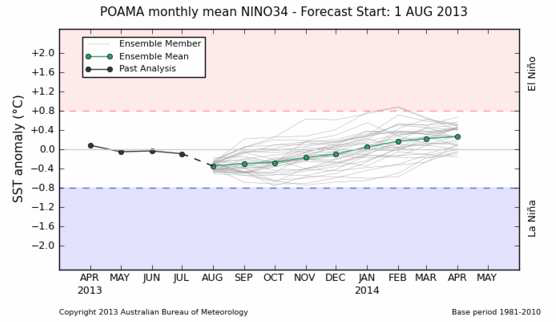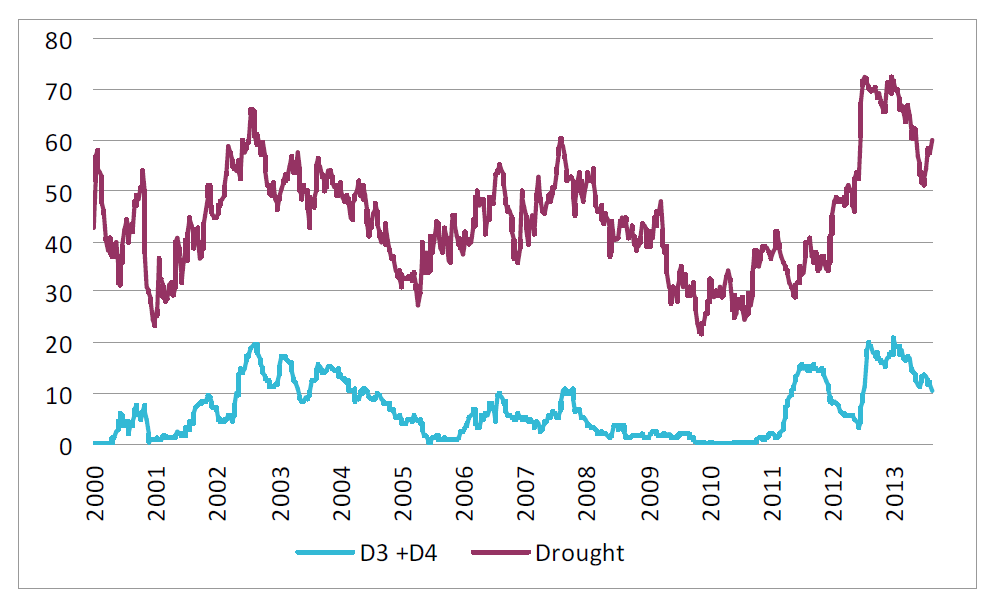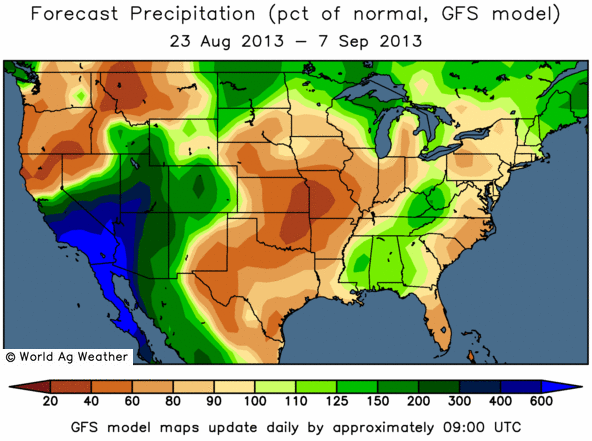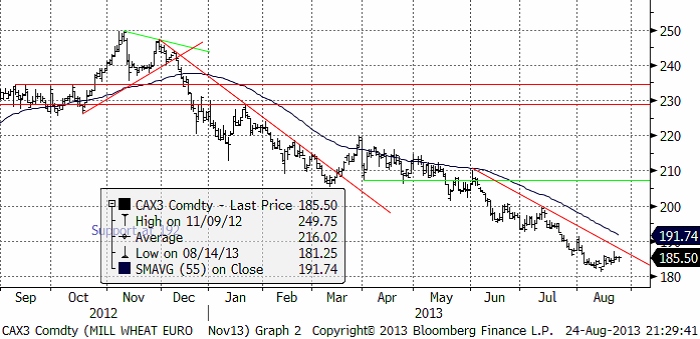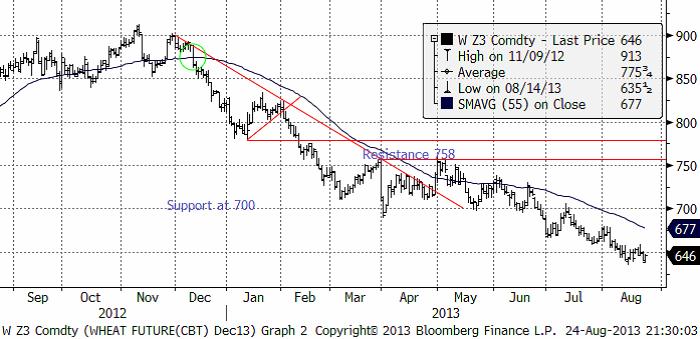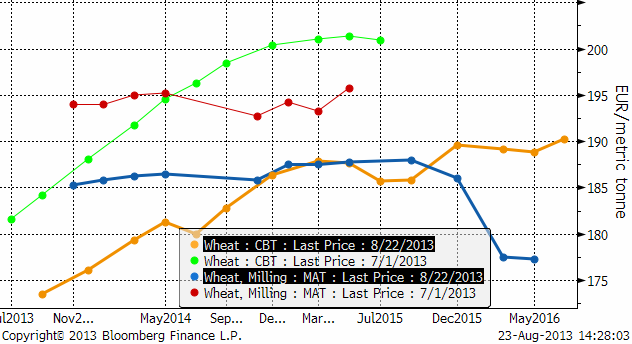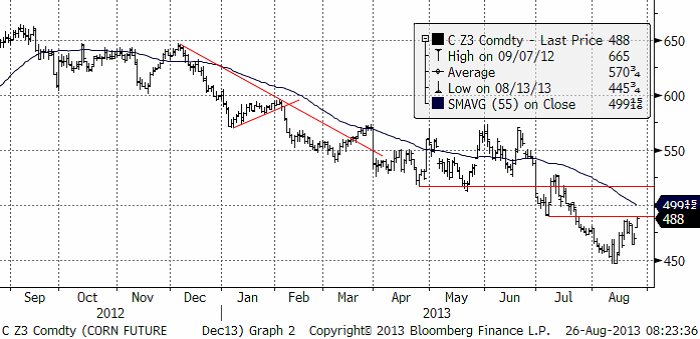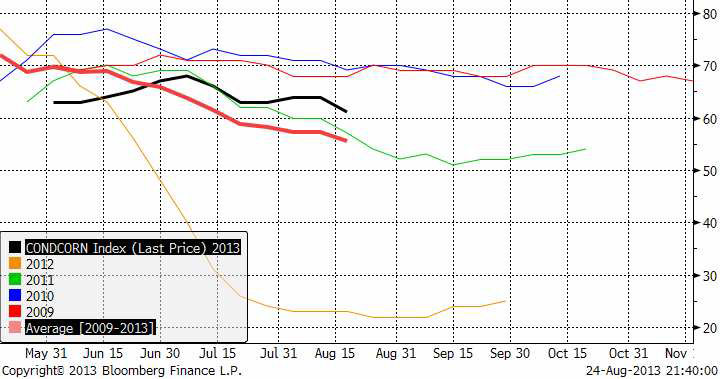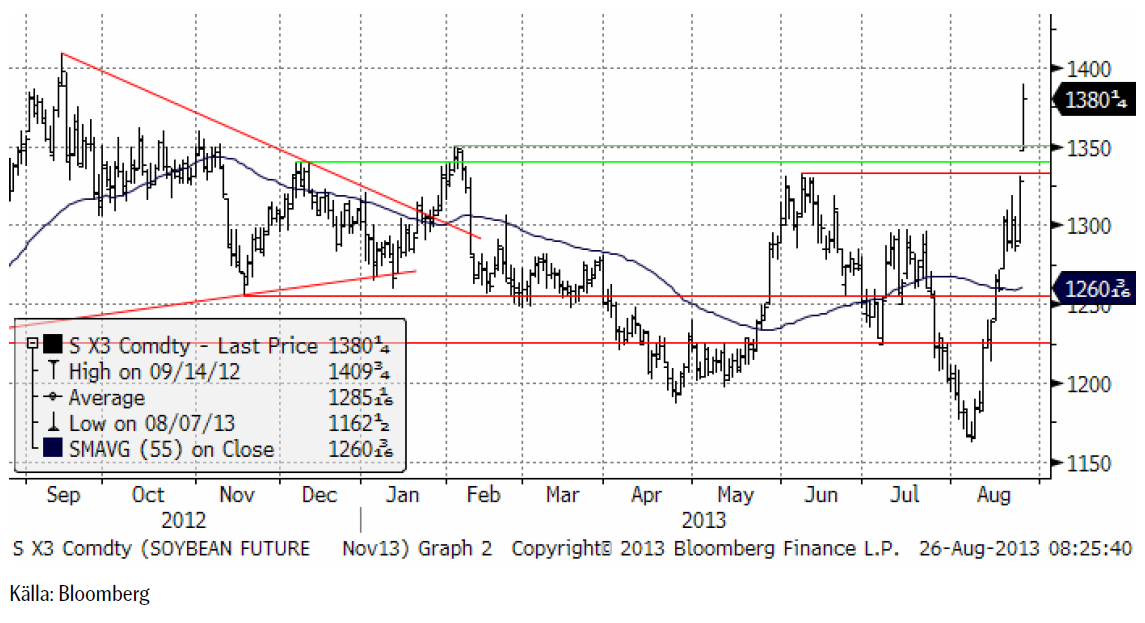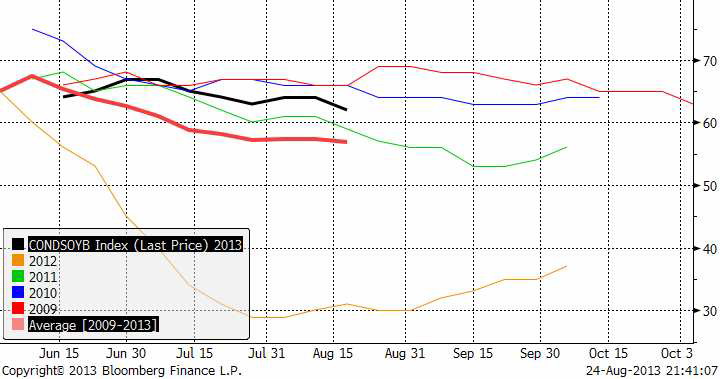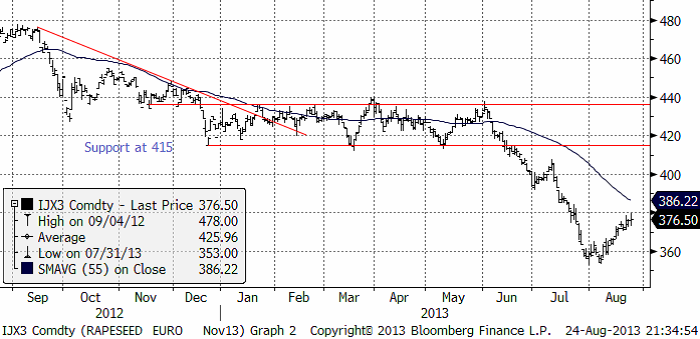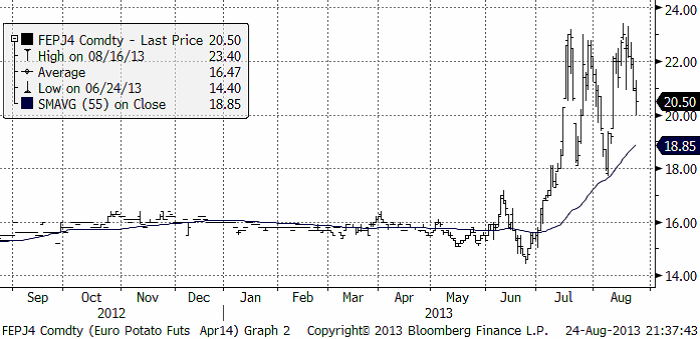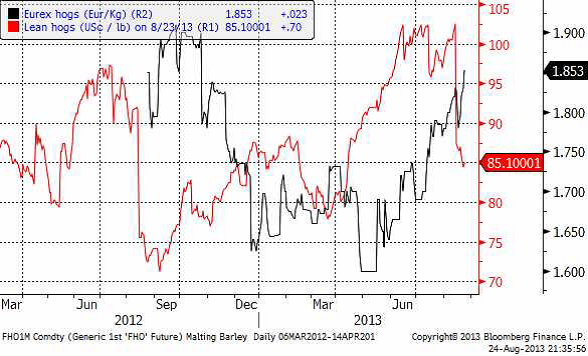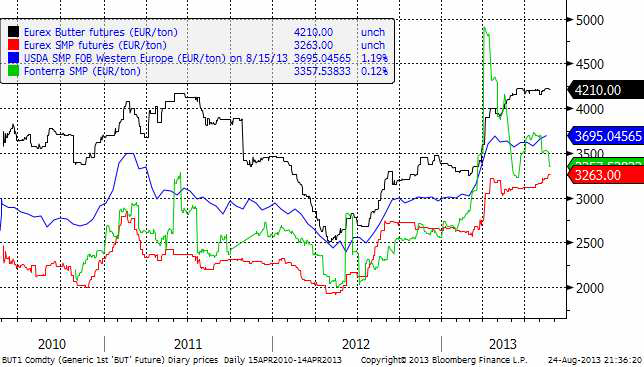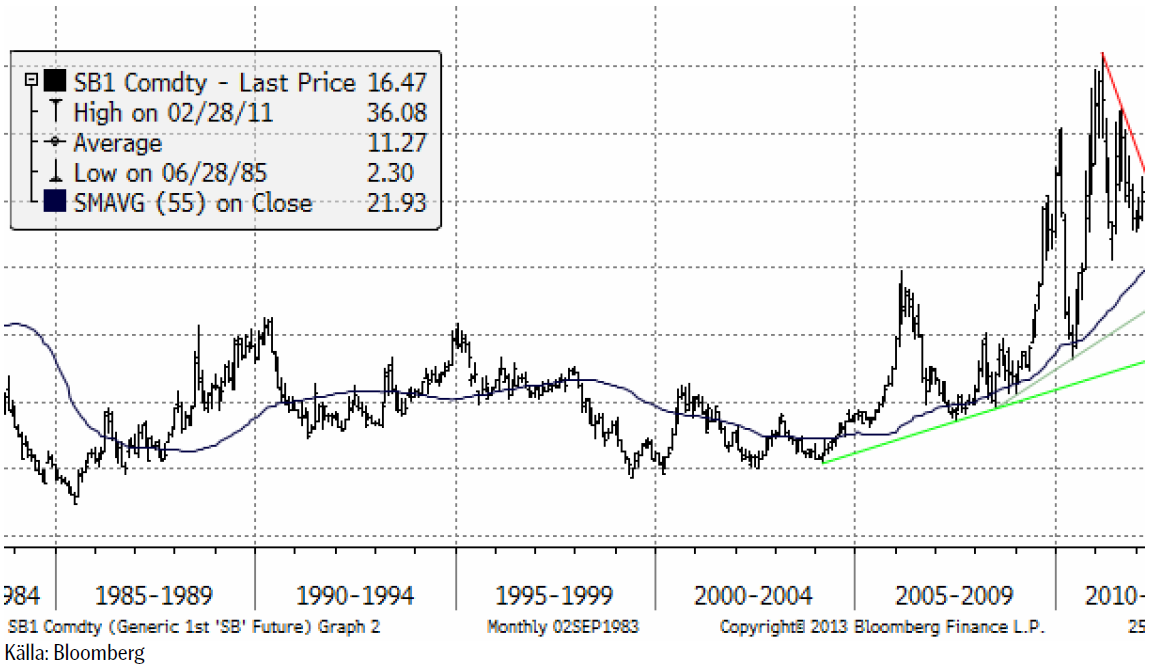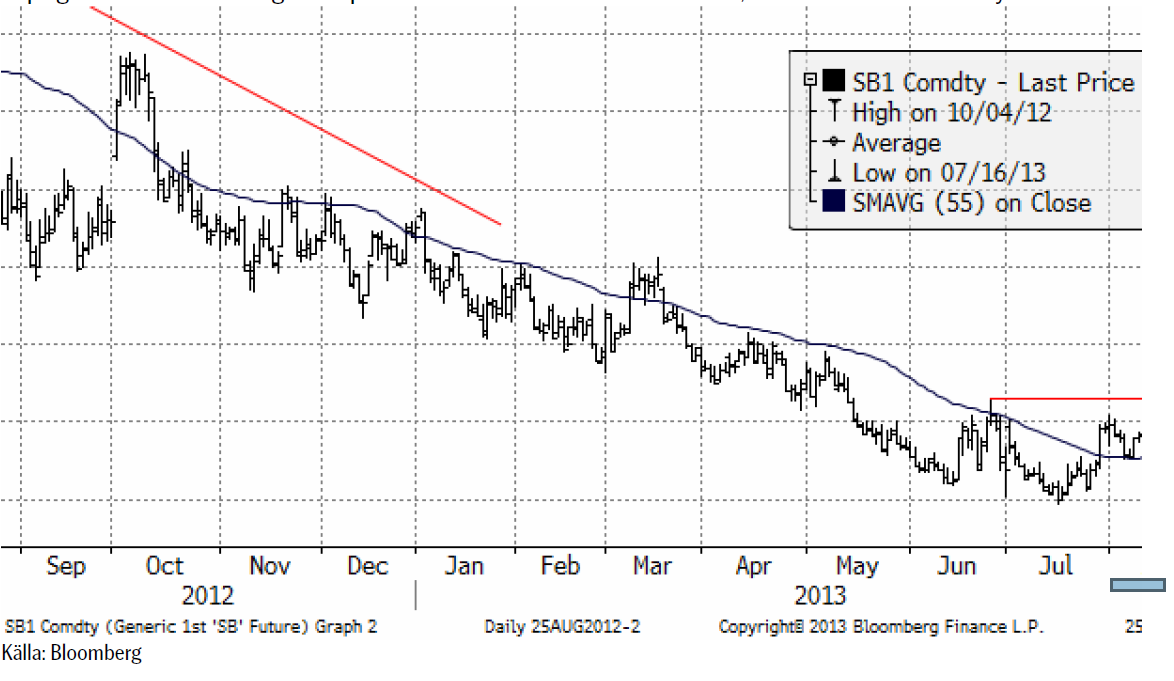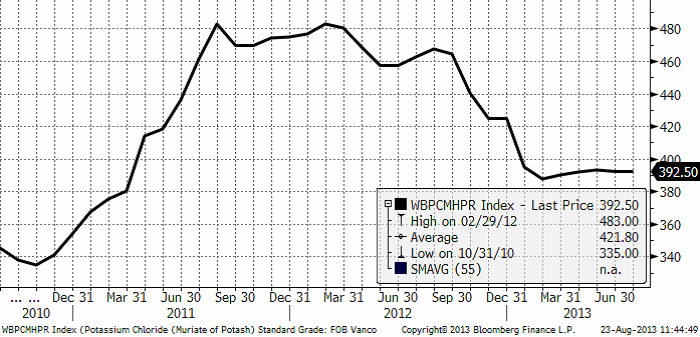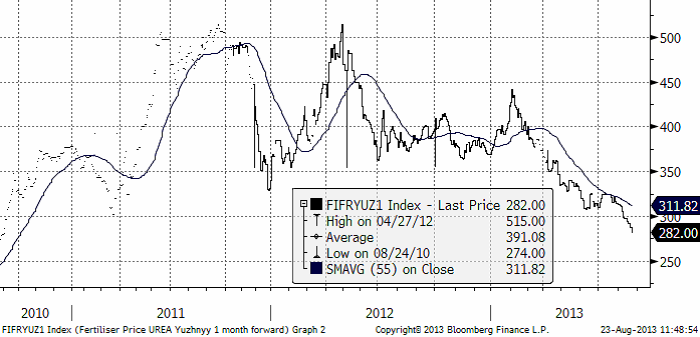Analys
SEB Jordbruksprodukter, 26 augusti 2013

 I detta första veckobrev efter sommaruppehållet går vi över till neutral på vete och majs, men behåller sälj på soja och raps. Raps har rekylerat upp och vi tycker man ska sälja terminer omedelbart. Vetemarknaden lider av nyhetstorka. Skörden av höstvete är klar på hela norra halvklotet och den har varit bra. Det finns inget mer ”ont” som kan hända skörden och inget extra gott heller. Då det inte finns några nyheter som kan ändra bilden, finns heller inte något som kan driva priset uppåt eller nedåt. Från Ryssland, varifrån information bitvis kan vara svårtolkad, kom dock information i veckan som gick. Den 14 augusti justerade den ryske jordbruksministern Nikolaj Fedorov ner produktionsestimatet för spannmål från 95 mt till 90 mt. Han anser att exportpotentialen är 18 – 20 mt. Hittills har 4 mt exporterats, jämfört med 3 mt samma tid förra året. Upp till 80% av den här spannmålsexporten utgörs av vete.
I detta första veckobrev efter sommaruppehållet går vi över till neutral på vete och majs, men behåller sälj på soja och raps. Raps har rekylerat upp och vi tycker man ska sälja terminer omedelbart. Vetemarknaden lider av nyhetstorka. Skörden av höstvete är klar på hela norra halvklotet och den har varit bra. Det finns inget mer ”ont” som kan hända skörden och inget extra gott heller. Då det inte finns några nyheter som kan ändra bilden, finns heller inte något som kan driva priset uppåt eller nedåt. Från Ryssland, varifrån information bitvis kan vara svårtolkad, kom dock information i veckan som gick. Den 14 augusti justerade den ryske jordbruksministern Nikolaj Fedorov ner produktionsestimatet för spannmål från 95 mt till 90 mt. Han anser att exportpotentialen är 18 – 20 mt. Hittills har 4 mt exporterats, jämfört med 3 mt samma tid förra året. Upp till 80% av den här spannmålsexporten utgörs av vete.
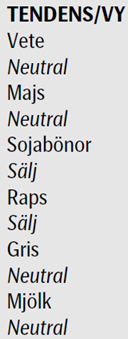 I övrigt är det från den amerikanska majs- och sojaskörden som informationen kommer. Den informationen påverkar marknaderna för raps och vete via den substitution som finns.
I övrigt är det från den amerikanska majs- och sojaskörden som informationen kommer. Den informationen påverkar marknaderna för raps och vete via den substitution som finns.
Pro Farmers crop tour avlöpte i veckan som gick. I tisdags var den i Indiana och den var åt det positiva hållet. Delstatens majs och sojabönor såg bra ut. Den estimerade avkastningen för majsen var 167.36 bu/acre, baserat på 180 stickprov. Förra året estimerade touren avkastningen till 113.25 bu/acre. Det treåriga genomsnittet är 141.14 bu/acre.
Soybean pod count, beräknad inom en 3 x 3 fots kvadrat, var 1,185.14, baserat på 175 stickprov. Förra årets tour uppmätte 1,033 pods och det treåriga genomsnittet är 1,136. I Iowa var det sämre ställt med sojabönorna. Typiskt sett var det bara 3 – 4 bönor per balja, mot normala 6 – 7. Illinois var också en negativ upplevelse. Marknaden tar säkert fasta på detta i det korta perspektivet.
Odlingsväder
Det blev ingen La Niña i sommar, inte ens lite grand. Ensembleprognosen visar att det inte blir någon under sommaren på södra halvklotet heller.
Nedan ser vi andelen av USA som är drabbat av torka. Den övre kurvan visar andelen som är drabbat av någon form av torka och den nedre visar den andel som är drabbat av de två värsta formerna av torka, ”extrem” och ”exceptionell”.
Som vi ser har torkan ökat från slutet av juli i USA, men inte den extrema varianten.
Nedan ser vi 15 dagars prognos för avvikelsen i nederbörd mot det normala i Nordamerika, enligt GFSmodellen.
Vi ser att det kommer att vara torrare än normalt i präriedelen av Mellanvästern och i South West. Det kommer också att vara varmare än normalt. Man kanske instinktivt tänker att detta inte är bra (priser upp). Men värme gör att sent sådd majs och soja mognar snabbare och detta är positivt. En omogen och sen skörd är inte bra för avkastningen heller.
Vete
November vetet på Matif har funnit tekniskt stöd vid 180 euro per ton. Om man frågar vem som helst i branschen vid vilket pris vetet bör ligga (som lägst) är svaret ”180 euro per ton”. Det amerikanska vetet handlas dock lägre än så, som man kan se nedan, om man räknar om priset till euro per ton. Kanske är ”180 euro per ton” bara något som bara finns i folks medvetande.
Regn i Tyskland har gjort att organisationen DBV varnat för proteinnivåerna i veteskörden, men stöder annars DRV:s estimat på veteskörden om 23.9 mt.
Decemberkontraktet på CBOT stängde i fredags på 646 cent per bushel. Det motsvarar 1500 kr per ton, eller ca 165 euro per ton.
Nedan ser vi terminskurvorna för Chicagovete och Matif-vete per den 1 juli och nu, omräknat till priser i euro per ton. Notera att det inte riktigt finns något contango (terminspåslag över spot) i Matifmarknaden. Notera också det mycket lägre priset för ny skörd 2014/15 på Matif! Det här är orsakat av fel i data. Det finns ännu ingen handel på den löptiden.
Vi tror att det finns ytterligare nedåtpotential i Matifvetet, men eftersom det inte finns något nyhetsflöde, kan denna justering bli trög, eller helt utebli. Vi går därför över till neutral rekommendation.
Det finns de som nu tänker lagra sin spannmål och som jag visade i boken ”Bättre betalt för skörden -riskhantering för lantbrukare”, finns ett contango i Chicago-marknaden som kan ge en lönsamhet. Historiskt har det ingen bra idé att lagra spannmål utan prissäkring, ens om den är ”billigare” än den varit tidigare.
Maltkorn
Maltkornet har fallit rejält – även i förhållande till vetet. För ölälskaren finns dock smolk. Tysklands skörd av humle är 40% mindre än normalt, rapporterade DBV förra veckan.
Majs
Majspriset (december 2013) steg initialt förra veckan på den allmänna rekyl uppåt som noterats i flera råvarumarknader som t ex guld, basmetaller och råolja, men föll sedan tillbaka. Det tekniska motståndet (inritat som röd horisontell linje i diagrammet nedan) höll. Idag, måndag gör marknaden ett nytt test av nivån. Ett brott uppåt skulle kunna ta priset till ca 500 – 516 cent per bushel.
Den observante läsaren minns kanske analysen i det här veckobrevet av WASDE-rapporten i maj. Där skrev vi att majspriset troligtvis skulle gå till 400 cent / bushel mot bakgrund av att lagren väntades öka till en nivå där 400 cent / bushel historiskt sett varit det normala. 450 cent är ur en risktagares perspektiv ”nära nog”. Den som är girig och vill hämta hem den allra sista pengen, kan gå miste om allt, så vi lämnar vår säljrekommendation och går över till neutral rekommendation.
Väderleksprognoserna visar fortsatt varmt väder i USA, vilket spontant kan tolkas som negativt. Efter ProFarmer crop tour, som påminde om att sådden skedde sent, kan värme dock tolkas som positivt, eftersom det gynnar tillväxten och skyndar på växten och minskar tiden till mognad och skörd.
61% av majsskörden är i ”good” eller ”excellent condition”, vilket är lite lägre än veckan innan.
Som nämnt ovan går vi alltså över till neutral rekommendation.
Sojabönor
Sojan har handlats upp rejält och bröt idag måndag det tekniska motståndet. Mycket av rörelsen är redan avklarad. 1400 cent per bushel är ett starkt motstånd och den ”flagga” av sidledes konsolidering som skedde kring 1300 cent, som brukar uppträda halvvägs i en rörelse, visar att prisuppgången nu praktiskt taget är klar. Det är ungefär lika långt från början av rörelsen (1200) upp till flaggan (vid 1300) som det är mellan 1300 och där priset är nu (nästan 1400).
62% av sojaskörden i USA är i ”good” eller ”excellent condition”, vilket är lite lägre än veckan innan, men väsentligt högre än genomsnittet för åren 2009 – 2013. Det ser ut att kunna bli en bra skörd. Däremot kommer säkerligen den förnyade torkan att ytterligare sänka crop rating i kvällens rapport. Kanske ner mot 61% eller 60%.
Slutsatsen, då uppgången troligtvis är avklarad till stor del, är att vi väljer en säljrekommendation, snarare än en neutral-rekommendation.
Raps
Rapspriset lär öppna upp idag på Matif. Rapspriset (November 2013) har rekylerat uppåt mot 380 euro per ton. 55-dagars glidande medelvärde, som många tittar på ligger strax ovanför. Sammantaget ger detta bilden av en marknad som har sträckt sig så långt uppåt som den kan just nu. Den huvudsakliga trenden är nedåtriktad och vi har sett EN rekyl uppåt, den som pågått sedan början av augusti. Det handlar med största sannolikhet om en rekyl och när den är färdig, bär det av nedåt igen. Det är ett säljläge just nu!
Stats Canada rapporterade i förra veckan en estimerad produktion på 14.7 mt. Det är 22% större än förra årets skörd.
Säljrekommendation på raps just nu alltså – köp av BEAR RAPS X4 S
Potatis
Jag brukar inte skriva om potatis, eftersom det aldrig varit någon som intresserat sig för prissäkring av potatis. Potatismarknaden är igång en kort period varje år, mellan oktober och april, ungefär. Korrelationen mellan det tyska kontraktet nedan och svensk matpotatis är mycket hög, ungefär 0.8 på årsbasis, mellan år.
Prisförändringar sker under sommaren. Så har skett även i sommar. Eftersom det varit perfekt semesterväder, har det inte varit bra för potatisen, vare sig i Tyskland eller Sverige (hög korrelation på semesterväder i Tyskland och Sverige). Det har fått priset att gå upp från 16 euro per deciton till 20 – 22 euro per ton för leverans i april nästa år, dvs för årets skörd. Kul för de producenter som aldrig brytt sig om att prissäkra. Mindre trevligt för köpare. Nästa år kan det gå åt andra hållet.
Gris
Lean hog, som tycks vara lite av en ledande indikator för de tyska grispriserna, har rasat med 15% i augusti. Eurexpriserna har däremot fortsatt upp och ligger nu på 1.85 euro per kilo för ”spotleverans”.
Mjölk
Botulism-bakterier har påträffats i Nya Zeelands mjölkindustri, vilket antagligen beror på otur i en mycket omfattande näringsverksamhet. Detta medför dock att ”spreaden” mellan Fonterrapriser och Eurexpriser går ihop. Det har påverkat Eurex SMP positivt. Det är allmänt positivt för svensk mjölk.
Foderpriserna har fortsatt att falla under sommaren, som vi sett ovan. I våras var bilden klar att de kommande åren kommer att innebära goda priser på mjölk och i synnerhet väsentligt lägre priser på proteinfoder och spannmål. Den här bilden har fortsatt att stärkas.
Socker
International Sugar Organization, baserad i London, publicerade sin senaste kvartalsrapport i torsdags (22 augusti). Enligt den kommer marknadsföringsåret 2013/14 (som löper från oktober till september) att bli det fjärde året med högre produktion än konsumtion på global basis. Sockerproduktionen väntas överstiga konsumtionen med 4.5 mt under 2013/14. Det är 1 mt högre än förra månaden, när organisationens estimat på överskottet var 4.5 mt. Innevarande år, 2012/13, är överskottet estimerat till 10.3 mt. ISO sade att ”It seems that a lower global surplus per se cannot be treated as a price supportive factor and the market may record further losses during the 2013/14 season”. ISO estimerar att global produktion faller med 1.2% till 180.8 mt. Det är den första minskningen sedan 2008/09. Efterfrågan ökar samtidigt med 2.1% till 176.3 mt. Detta innebär att globala lager ökar med 0.5% till 74.4 mt vid utgången av 2013/14 (sista september nästa år), men lager i förhållande till konsumtion minskar faktiskt från 42.9% till 42.2%, enligt ISO.
De låga priserna har alltså haft en effekt på produktionen, huvudsakligen där betor odlas, eftersom detta till skillnad från sockerrör är en ettårig växt. Ukrainas produktion väntas av ISO minska med 21% till 1.9 mt.
Indiens produktion väntas också minska, men i Brasilien väntas produktionen faktiskt öka med 2% till 41.1 mt. Både Indien och Brasilien bedriver ekonomisk politik som är oekonomisk med fallande valuta som följd. Produktion och export av jordbruksprodukter blir då en uppenbar källa till inkomster för Brasilien. Indien har däremot ett ineffektivt regelverk, som inte stimulerar på samma sätt.
Råvarugurun Jim Rogers nämnde socker som en intressant råvara att investera i, i en intervju i Economic Times förra veckan. Nedan ser vi prisutvecklingen på socker (cent per pund) de senaste 30 åren. Vi ser att prisnivån 15 cent tycks vara en nivå som ömsom varit ett motstånd och ömsom en stödnivå.
Det senaste årets kursutveckling för spotkontraktet ser vi nedan. Marknaden gjorde ett test av en motståndsnivå i mitten av augusti, men rekylerade tillbaka. Ett brott av den motståndsnivån skulle ge oss en köpsignal och en anledning att köpa BULL SOCKER X4 S eller SOCKER S, om man inte vill ta så mycket risk.
Vi fortsätter med neutral rekommendation.
Gödsel
Den internationella potash-kartellen (kalium) föll samman i slutet av juli. Den direkta konsekvensen tycks mest ha påverkat producentbolagens aktiekurser. ”POT” föll från 38 dollar till 30 på ett par dagar. Vi ser kursdiagrammet nedan:
För Yara, som är ett bolag som köper kalium för gödselblandningar hade detta ingen effekt – om någon, något positiv (aktien gick upp lite, efter några dagar). Däremot tycks inte priset på kalium ha påverkats – än – som vi ser i prisdiagrammet på kaliumklorid nedan (standard grade, fob Vancouver, spot price) i USD/ton.
Med fallande priser på spannmål har priset på urea fortsatt att falla. Nedan ser vi priset på urea FOB Yuzhnyy, 1 månads termin, i dollar / ton.
[box]SEB Veckobrev Jordbruksprodukter är producerat av SEB Merchant Banking och publiceras i samarbete och med tillstånd på Råvarumarknaden.se[/box]
Disclaimer
The information in this document has been compiled by SEB Merchant Banking, a division within Skandinaviska Enskilda Banken AB (publ) (“SEB”).
Opinions contained in this report represent the bank’s present opinion only and are subject to change without notice. All information contained in this report has been compiled in good faith from sources believed to be reliable. However, no representation or warranty, expressed or implied, is made with respect to the completeness or accuracy of its contents and the information is not to be relied upon as authoritative. Anyone considering taking actions based upon the content of this document is urged to base his or her investment decisions upon such investigations as he or she deems necessary. This document is being provided as information only, and no specific actions are being solicited as a result of it; to the extent permitted by law, no liability whatsoever is accepted for any direct or consequential loss arising from use of this document or its contents.
About SEB
SEB is a public company incorporated in Stockholm, Sweden, with limited liability. It is a participant at major Nordic and other European Regulated Markets and Multilateral Trading Facilities (as well as some non-European equivalent markets) for trading in financial instruments, such as markets operated by NASDAQ OMX, NYSE Euronext, London Stock Exchange, Deutsche Börse, Swiss Exchanges, Turquoise and Chi-X. SEB is authorized and regulated by Finansinspektionen in Sweden; it is authorized and subject to limited regulation by the Financial Services Authority for the conduct of designated investment business in the UK, and is subject to the provisions of relevant regulators in all other jurisdictions where SEB conducts operations. SEB Merchant Banking. All rights reserved.
Analys
Tightening fundamentals – bullish inventories from DOE

The latest weekly report from the US DOE showed a substantial drawdown across key petroleum categories, adding more upside potential to the fundamental picture.

Commercial crude inventories (excl. SPR) fell by 5.8 million barrels, bringing total inventories down to 415.1 million barrels. Now sitting 11% below the five-year seasonal norm and placed in the lowest 2015-2022 range (see picture below).
Product inventories also tightened further last week. Gasoline inventories declined by 2.1 million barrels, with reductions seen in both finished gasoline and blending components. Current gasoline levels are about 3% below the five-year average for this time of year.
Among products, the most notable move came in diesel, where inventories dropped by almost 4.1 million barrels, deepening the deficit to around 20% below seasonal norms – continuing to underscore the persistent supply tightness in diesel markets.
The only area of inventory growth was in propane/propylene, which posted a significant 5.1-million-barrel build and now stands 9% above the five-year average.
Total commercial petroleum inventories (crude plus refined products) declined by 4.2 million barrels on the week, reinforcing the overall tightening of US crude and products.


Analys
Bombs to ”ceasefire” in hours – Brent below $70

A classic case of “buy the rumor, sell the news” played out in oil markets, as Brent crude has dropped sharply – down nearly USD 10 per barrel since yesterday evening – following Iran’s retaliatory strike on a U.S. air base in Qatar. The immediate reaction was: “That was it?” The strike followed a carefully calibrated, non-escalatory playbook, avoiding direct threats to energy infrastructure or disruption of shipping through the Strait of Hormuz – thus calming worst-case fears.

After Monday morning’s sharp spike to USD 81.4 per barrel, triggered by the U.S. bombing of Iranian nuclear facilities, oil prices drifted sideways in anticipation of a potential Iranian response. That response came with advance warning and caused limited physical damage. Early this morning, both the U.S. President and Iranian state media announced a ceasefire, effectively placing a lid on the immediate conflict risk – at least for now.
As a result, Brent crude has now fallen by a total of USD 12 from Monday’s peak, currently trading around USD 69 per barrel.
Looking beyond geopolitics, the market will now shift its focus to the upcoming OPEC+ meeting in early July. Saudi Arabia’s decision to increase output earlier this year – despite falling prices – has drawn renewed attention considering recent developments. Some suggest this was a response to U.S. pressure to offset potential Iranian supply losses.
However, consensus is that the move was driven more by internal OPEC+ dynamics. After years of curbing production to support prices, Riyadh had grown frustrated with quota-busting by several members (notably Kazakhstan). With Saudi Arabia cutting up to 2 million barrels per day – roughly 2% of global supply – returns were diminishing, and the risk of losing market share was rising. The production increase is widely seen as an effort to reassert leadership and restore discipline within the group.
That said, the FT recently stated that, the Saudis remain wary of past missteps. In 2018, Riyadh ramped up output at Trump’s request ahead of Iran sanctions, only to see prices collapse when the U.S. granted broad waivers – triggering oversupply. Officials have reportedly made it clear they don’t intend to repeat that mistake.
The recent visit by President Trump to Saudi Arabia, which included agreements on AI, defense, and nuclear cooperation, suggests a broader strategic alignment. This has fueled speculation about a quiet “pump-for-politics” deal behind recent production moves.
Looking ahead, oil prices have now retraced the entire rally sparked by the June 13 Israel–Iran escalation. This retreat provides more political and policy space for both the U.S. and Saudi Arabia. Specifically, it makes it easier for Riyadh to scale back its three recent production hikes of 411,000 barrels each, potentially returning to more moderate increases of 137,000 barrels for August and September.
In short: with no major loss of Iranian supply to the market, OPEC+ – led by Saudi Arabia – no longer needs to compensate for a disruption that hasn’t materialized, especially not to please the U.S. at the cost of its own market strategy. As the Saudis themselves have signaled, they are unlikely to repeat previous mistakes.
Conclusion: With Brent now in the high USD 60s, buying oil looks fundamentally justified. The geopolitical premium has deflated, but tensions between Israel and Iran remain unresolved – and the risk of missteps and renewed escalation still lingers. In fact, even this morning, reports have emerged of renewed missile fire despite the declared “truce.” The path forward may be calmer – but it is far from stable.
Analys
A muted price reaction. Market looks relaxed, but it is still on edge waiting for what Iran will do

Brent crossed the 80-line this morning but quickly fell back assigning limited probability for Iran choosing to close the Strait of Hormuz. Brent traded in a range of USD 70.56 – 79.04/b last week as the market fluctuated between ”Iran wants a deal” and ”US is about to attack Iran”. At the end of the week though, Donald Trump managed to convince markets (and probably also Iran) that he would make a decision within two weeks. I.e. no imminent attack. Previously when when he has talked about ”making a decision within two weeks” he has often ended up doing nothing in the end. The oil market relaxed as a result and the week ended at USD 77.01/b which is just USD 6/b above the year to date average of USD 71/b.

Brent jumped to USD 81.4/b this morning, the highest since mid-January, but then quickly fell back to a current price of USD 78.2/b which is only up 1.5% versus the close on Friday. As such the market is pricing a fairly low probability that Iran will actually close the Strait of Hormuz. Probably because it will hurt Iranian oil exports as well as the global oil market.
It was however all smoke and mirrors. Deception. The US attacked Iran on Saturday. The attack involved 125 warplanes, submarines and surface warships and 14 bunker buster bombs were dropped on Iranian nuclear sites including Fordow, Natanz and Isfahan. In response the Iranian Parliament voted in support of closing the Strait of Hormuz where some 17 mb of crude and products is transported to the global market every day plus significant volumes of LNG. This is however merely an advise to the Supreme leader Ayatollah Ali Khamenei and the Supreme National Security Council which sits with the final and actual decision.
No supply of oil is lost yet. It is about the risk of Iran closing the Strait of Hormuz or not. So far not a single drop of oil supply has been lost to the global market. The price at the moment is all about the assessed risk of loss of supply. Will Iran choose to choke of the Strait of Hormuz or not? That is the big question. It would be painful for US consumers, for Donald Trump’s voter base, for the global economy but also for Iran and its population which relies on oil exports and income from selling oil out of that Strait as well. As such it is not a no-brainer choice for Iran to close the Strait for oil exports. And looking at the il price this morning it is clear that the oil market doesn’t assign a very high probability of it happening. It is however probably well within the capability of Iran to close the Strait off with rockets, mines, air-drones and possibly sea-drones. Just look at how Ukraine has been able to control and damage the Russian Black Sea fleet.
What to do about the highly enriched uranium which has gone missing? While the US and Israel can celebrate their destruction of Iranian nuclear facilities they are also scratching their heads over what to do with the lost Iranian nuclear material. Iran had 408 kg of highly enriched uranium (IAEA). Almost weapons grade. Enough for some 10 nuclear warheads. It seems to have been transported out of Fordow before the attack this weekend.
The market is still on edge. USD 80-something/b seems sensible while we wait. The oil market reaction to this weekend’s events is very muted so far. The market is still on edge awaiting what Iran will do. Because Iran will do something. But what and when? An oil price of 80-something seems like a sensible level until something do happen.
-

 Nyheter4 veckor sedan
Nyheter4 veckor sedanStor uppsida i Lappland Guldprospekterings aktie enligt analys
-

 Nyheter4 veckor sedan
Nyheter4 veckor sedanSilverpriset släpar efter guldets utveckling, har mer uppsida
-

 Nyheter3 veckor sedan
Nyheter3 veckor sedanUppgången i oljepriset planade ut under helgen
-

 Nyheter3 veckor sedan
Nyheter3 veckor sedanLåga elpriser i sommar – men mellersta Sverige får en ökning
-

 Nyheter2 veckor sedan
Nyheter2 veckor sedanMahvie Minerals växlar spår – satsar fullt ut på guld
-

 Analys3 veckor sedan
Analys3 veckor sedanVery relaxed at USD 75/b. Risk barometer will likely fluctuate to higher levels with Brent into the 80ies or higher coming 2-3 weeks
-

 Nyheter1 vecka sedan
Nyheter1 vecka sedanOljan, guldet och marknadens oroande tystnad
-

 Nyheter1 vecka sedan
Nyheter1 vecka sedanJonas Lindvall är tillbaka med ett nytt oljebolag, Perthro, som ska börsnoteras


